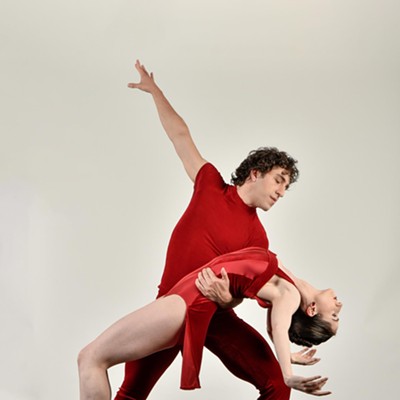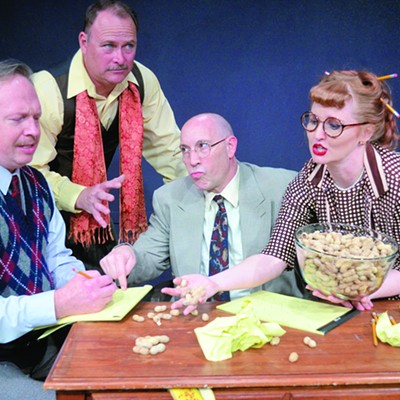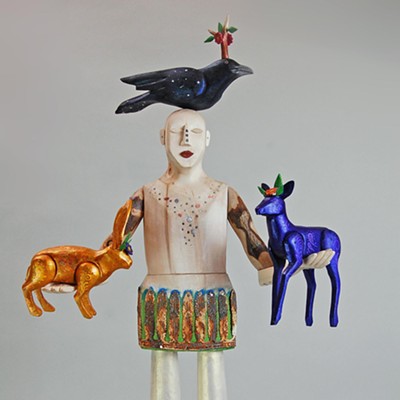The Historical Effectiveness of a Poem
American Indian Studies hosts National Poetry Month in Tucson7 p.m., Friday, April 7
Barnes and Noble, 5120 E. Broadway Blvd.
512-0758
There's a famous Denise Levertov quote that goes like this: "I don't think one can accurately measure the historical effectiveness of a poem; but one does know, of course, that books influence individuals; and individuals, although they are part of large economic and social processes, influence history. Every mass is after all made up of millions of individuals."
"My Favorite Poem Project," a National Poetry Month event hosted by the UA American Indian Studies Program and directed by award-winning poet and professor Luci Tapahonso, lets individuals consider how poems have influenced their personal histories. The project, which begins on April 7 at 7 p.m. and continues every Friday night in April, is modeled after then-U.S. Poet Laureate Robert Pinsky's original project in 1998.
"It's been incredible to see how responsive people are," Tapahonso says of those she's contacted to read their two favorite poems. "They are so happy to come and share their poems, and it says a lot about Tucson and how people value language. I think the idea of poetry is really overlooked sometimes."
The diverse April 7 lineup will do its best to not overlook poetry in any of its incarnations. Readers include Tapahonso; chef Janos Wilder; Doolen Middle School student Teyvan Lowe; nationally acclaimed artist Emmi Whitehorse; Habitat for Humanity Tucson's Michael McDonald; Mark Bahti, owner of Bahti Indian Arts; UA graduate student Amy Fatzinger; Ian Record of Native Nations Institute; Tohono O'odham traditional leaders and educators Florence and Daniel Lopez; Arizona Daily Star reporter Levi Long; and UA law student Wizipan Garriott.
Additional readings take place on April 14, 21 and 28. Same time, same place; different readers each time. The readings are free and open to the public. --M.H.
Park the Car!
Clean Air FairVarious times, Thursday, April 6, through Sunday, April 9
Locations vary; see www.tucsonaz.gov/caf for details
740-3947
Beth Gorman wants you to consider the billions upon billions of advertising dollars that are poured into commercials that show, for example, a sexy, red car twisting and turning down moist, moonlit streets and into verdant, fairy-tale forests.
"But that's not a reality," Gorman says of the car-lust indoctrination. "It's really hard to fight against that. We go out to schools and talk with kids, and now, we hope those kids from years and years ago started carpooling, riding their bikes and walking more."
Gorman, program manager of the Pima County Department of Environmental Quality, organizes the city's annual Clean Air Fair. The county and city have worked together for more than 12 years to improve air quality and lessen traffic congestion through events like these, Gorman says.
"For years and years, we've done events to highlight alternative modes of transportation, but they've gone under different names," Gorman says. "This is the third year of the Clean Air Fair. ... I think people want healthy air. We don't want what happened in Phoenix to happen down here. ... People just need a reminder of the things they can do to reduce air pollution."
In the spirit of reminding folks of what they can do, the four-day fair highlights Bike to Work Day and Walk 'n' Roll to School Day on April 7; Magical History Walking Tours on April 8; and Sun Tran's Free Ride Day and the Clean Air Jam with traditional Irish music and groups including the Bad News Blues Band, Sunday Afternoon and Hayley Jane on April 9. There's a lot more to the fair than this, though.
To find out more about additional events, dates and times for this free multi-day event, visit
www.tucsonaz.gov/caf . --M.H.
Digital Underground
Stephen Marc presents his work on the Underground Railroad5 p.m., Wednesday, April 12
UA Integrated Learning Center, 1500 E. University Drive
621-5665; herbergercollege.asu.edu/marc/story.html
Esteemed photographer Stephen Marc explains his creative process as a foot race. If there are moments when the race is mental and physical, Marc says, there are also moments when the process transcends bodily limitations and becomes spiritual. When one is in the proverbial "zone," the shots become intuitive, even if the end result is not yet known.
Marc's art embodies this metaphor in his digitally enhanced documentary style of photography, and his current project, Passage on the Underground Railroad. Marc's use of metaphor, implied narrative, community-inspired art and montage/composite photography allow viewers to re-enact the holistic implications of the Underground Railroad beyond a static, single-shot approach. It's amazing to see what Marc creates with several Olympus Visionary cameras and Photoshop.
Marc has shot thousands of photographs of people and places connected to the Underground Railroad in 22 states and Canada. Much of his work blends historical texts with contemporary images of African-American culture and the Underground Railroad.
On Wednesday, Marc presents his award-winning photography in a presentation titled "Walking in the Footsteps: Documenting the Remnants of Slavery and the Underground Railroad." The UA Africana Studies program brings Marc to Tucson from Tempe, where he is a professor of art at Arizona State's Herberger College of Fine Arts. Marc is also the author of several books, including The Black Trans-Atlantic Experience: On Street Life and Culture in Ghana, Jamaica, England and the United States.
During the free presentation, Marc will also discuss the stories behind his photographs and adventures. --M.H.
A Fair of One's Own
Optimum Health Fair for Women and Families10 a.m. to 2 p.m., Sunday, April 9
Tucson Jewish Community Center, 3800 E. River Road
299-3000; www.tucsonjcc.org
Like many first-time event planners, Marcia Abelson didn't know what to expect when she organized the first Optimum Health Fair for Women and Families in 2004.
"You don't know what's going to happen and how logistically it's going to work," Abelson says of the first fair, which drew 400 people. "... But we knew we had a successful event from the comments and the turnout."
Abelson and her fellow co-chairs, Ruthie Zales and Lee Surwit, volunteers for the Women's Division of the Jewish Federation of Southern Arizona, didn't host the fair in 2005. Abelson celebrated her daughter's bat mitzvah, and a rest was needed to plan for 2006.
"We planned on giving it a big break, because it was a very big undertaking," Abelson says. So when Abelson regrouped with her co-chairs and the Jewish Community Center, she knew what to do to make the second health fair even better.
"We looked at the reviews and suggestions from people when looking for speakers (this year)," Abelson says. "We probably honed in more on what the community is looking for from doctors and other health professionals in the community."
The free four-hour fair hosts dozens of lectures and workshops by health-care professionals and experts covering wellness, prevention and general health issues (including men's health topics); diagnostic screenings; and sample fitness classes.
"I think in a lot of ways, women are more responsible for health matters for their family in general, though I'm sure that's not always the case," Abelson says, explaining why men and children's health issues are also included. "We still included matters for children and things like that, because in most cases, it's the mother who hones in on the health issues of the family." --M.H.







